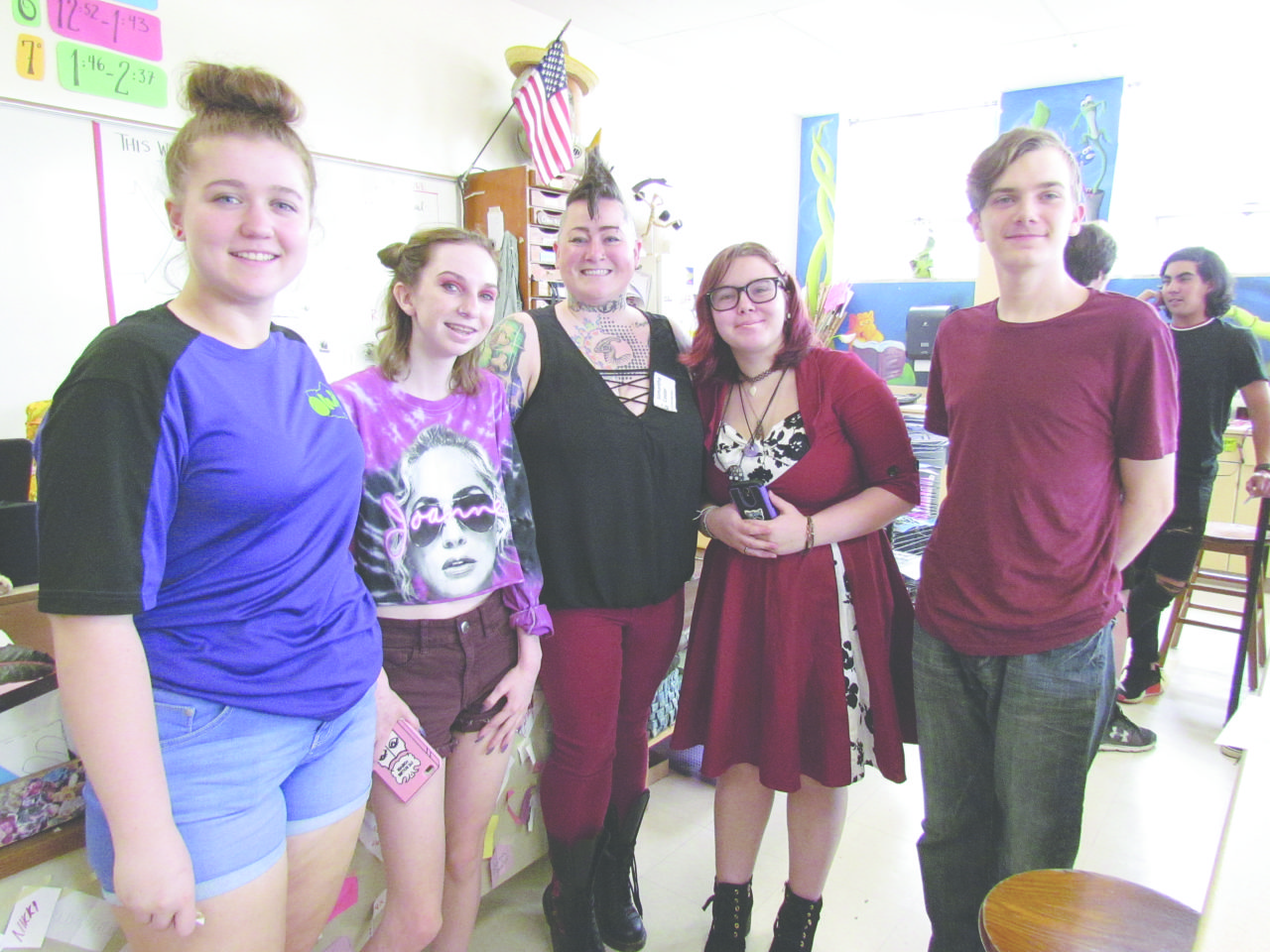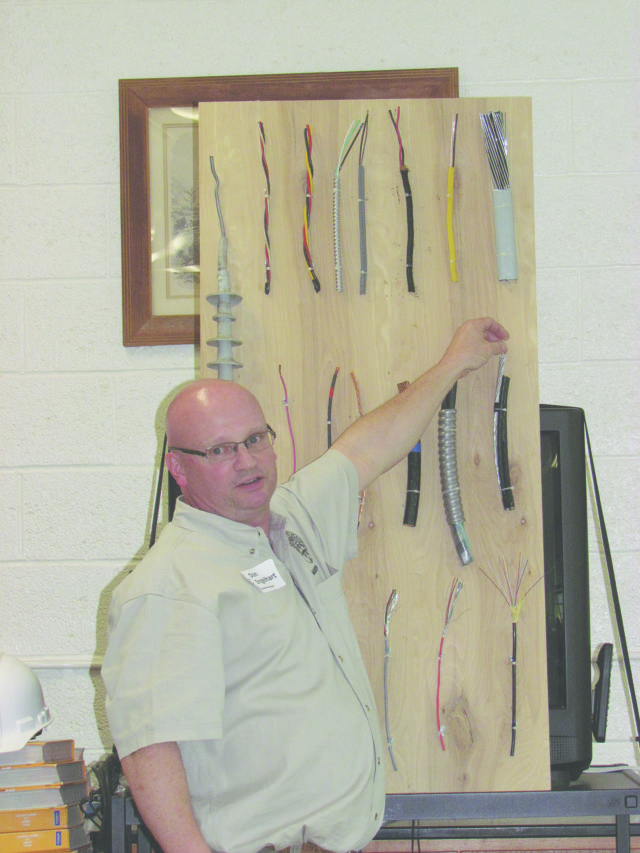Garrettsville – “We spend a lot of time teaching things like math, science, and how to write,” Libby Frato-Sweeney explained,” but not so much about what happens after graduation.” In an effort to better prepare students for what comes next, Frato-Sweeney, who teaches art as well as college & career readiness at James A. Garfield High School, planned this first event with fellow teacher Doug Engelhart.
One of the goals of the program, in addition to providing students with first-hand knowledge of a wide variety of career options was the access to local experts that students received. Each small group session afforded students with ample opportunity to have their questions answered in a group setting, or one-on-one. Students asked questions about intriguing jobs, like psychologist, pyrotechnician, nursing, realty — even tattoo artistry — to find out what path each person took to reach it. “And regardless of a student’s path after high school, they’re learning valuable life skills, like talking to adults or networking with graduates,” Frato-Sweeney added.

To create the program, staff and administration reached out to friends, family, and recent graduates to invite a wide array of potential career options, bringing the work world to roughly 400 high schoolers in grades nine through twelve. Their requests were wildly successful, bringing in forty-two individuals, including nine recent JAG HS graduates attending college and eight JAG graduates currently working in and around Northeast Ohio. High School Principal Kathleen Kisabeth reached out to her father, Engelhart enlisted the help of his friends and his older brother, Don, a journeyman electrician, to attend the special event. He also reached out to JAG grads online.
Speakers included more traditional professionals like marketing, business, finance, insurance, and accounting. Trade skills included an electrician, diesel and automotive mechanics. Representatives from the Portage County Sheriff’s Office, the fire department, a truck driving school, and the US Air Force were also present to meet with students and provide insight. Several groups even took walking tours to nearby Kepich Ford and Just For Kids childcare center to see firsthand what these jobs entail. In addition, ten recent JAG graduates currently attending or recently graduated from college took part in a panel discussion about preparing for college, their majors, and what to expect after high school graduation.
Students selected their own schedule for the afternoon event held at James A. Garfield High School. They had the opportunity to attend up to six sessions covering occupations that ranged from blue collar to PhD. To encourage this interaction, students were encouraged to take a selfie with their favorite speakers. Those students who shared their photos on Twitter using #selfiewithspeaker earned a chance to win a prize.
JAG graduate Robert Altemus was among those presenting. He explained his role at the Sheriff’s Department, including the education path that led him there. He spoke in his former teacher, Mr. Norton’s classroom. Norton, who remembered Altemus from his days as a student, described him as a typical high school boy, but added, “this isn’t the side of the law you’d expect him to end up on.” Altemus chuckled, speaking to students, “It’s never to late to change, whether its behavior issues or getting in trouble.” He shared that the most rewarding part of his job is helping people find their way.

Cosmetologist and JAG alumni Abbie Brown shared that her job at Salon Patrick in Aurora offers an ideal amount of variety, including hair design, nails, massages, and facials. She noted that since she suffers from attention deficit disorder (ADD), her ideal career wouldn’t involve doing the same thing each day, and cosmetology is an expressive industry that provides a creative outlet as well. In addition, her career is recession-proof, since men and women will continue to need haircuts. As with many occupations today, her industry is fueled by social media — whether searching for an apprenticeship, building up clientele, or networking.
Samantha Coster also works in an expressive industry. She’s a tattoo artist from War Horse Ink in Ravenna, and she kept students enthralled with both her colorful personality and her unique body art. “I love my job!“ she beamed to students. ”I’m blessed to wake up and do art all day.” She explained the path led from her role as a nanny to expressing her creativity as a tattoo artist running a local shop. Her job is very gratifying, “I can say ‘enjoy your art forever!’” when a happy client exits. She did caution students contemplating a tattoo to use a reputable artist, warning that while bad tattoos can be sometimes be ‘fixed’, tattoo removal is done with a laser, and it’s a painful process.
Don Engelhart shared that as a high school freshman, he learned that college preparatory courses were not for him. He excelled at hands-on activities, and upon graduation, he decided to pick up a trade. After an apprenticeship with an electrician, he completed more training to become a journeyman electrician, With skills applicable in homes, commercial structures, and industrial settings, he’s done very well for himself and his family.
Mike Horvath from the TDDS Technical Institute, shared details of the opportunities for men and women in the transportation industry. Whether interested in a career as a diesel technician working on large engines, or earning a commercial driver license, he acknowledged that opportunities abound and if students are willing to ‘show up and do the work,” they can be as successful as they want to be.
Abe Szoka concurred with that idea. Szoka is an automotive technician at Aurora Car Care, where he specializes in diagnostic work, making sure that customers’ automotive issues have been resolved. His passion for all things automotive began in high school as a vocational education student who wanted to learn “how everything on a car worked.” While enlisted in the National Guard, he learned how to repair diesel and automotive engines, as well as a fair number of computer skills ideal for automotive diagnostics, while earning his two-year degree. He shared that much of the training received in the military can help prepare for civilian life. He shared that his industry has a shortage of qualified technicians due to retirements and the exponential growth, making it an excellent opportunity to consider.
Air Force recruiter Staff Sergeant Curtis Brewer was present to share opportunities with students, as well. High school seniors John and Tom signed letters of intent that day attracted by the technical training and opportunities that can be found in the service. John, who will be trained in munitions, chose his path since it’s “a good career that would help people.” Tom shared, “It’s always been something I wanted to do.”
Michaela Weisbarth, a student at the Columbus College of Art & Design, returned in order to advise fellow artists like herself who may have be discouraged from pursuing art as a career, or told not to become a ‘starving artist’. “Art is such a diverse field, with opportunities to pursue your specific passion,” she explained. From concept art, to character design, photography to animation, the opportunities are vast. An accredited school like hers provides assistance seeking internships, job opportunities, and opportunities to study abroad. “A good program can help you do what you love, and not become a starving artist.”
Jill Jividen, PhD, a counselor who specializes in treating emotional trauma, answered questions about the path she took to find her career, from receiving an undergraduate degree, to her eventual Masters. In addition, she walked students through a simple exercise she finds helpful in her counseling business that can help alleviate anxiety.
Samantha Martin, a JAG graduate who now works as the Director of Marketing and Events at Goldhorn Brewery verbalized some of the decisions graduates will be facing as they head out to make their way in the world. She shared that working crazy hours at a large company will let you earn a lot of money, but working for less money at a smaller company may provide better work/life balance. Martin was thrilled at the opportunity to speak with students, sharing, “I wish we had this when I was here! Growing up in a small town, you may not always be aware of what’s out there.”















